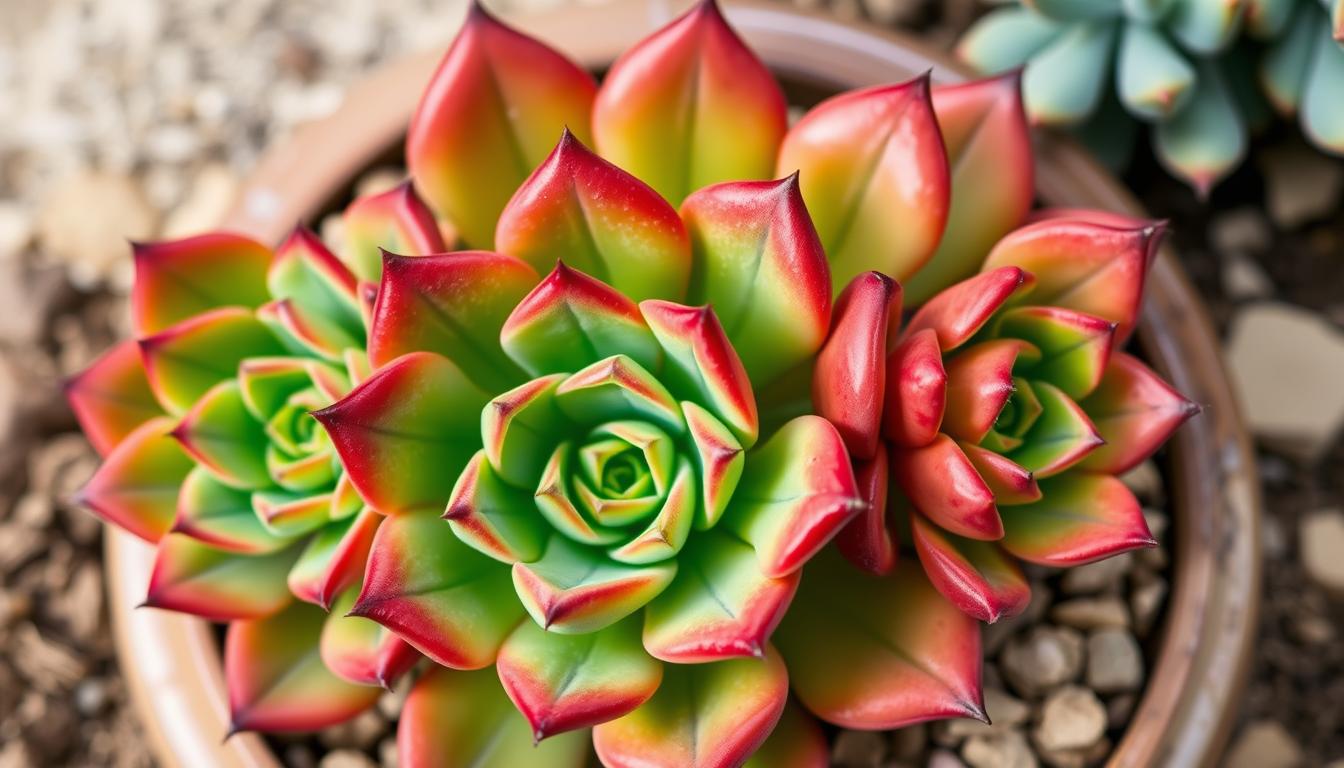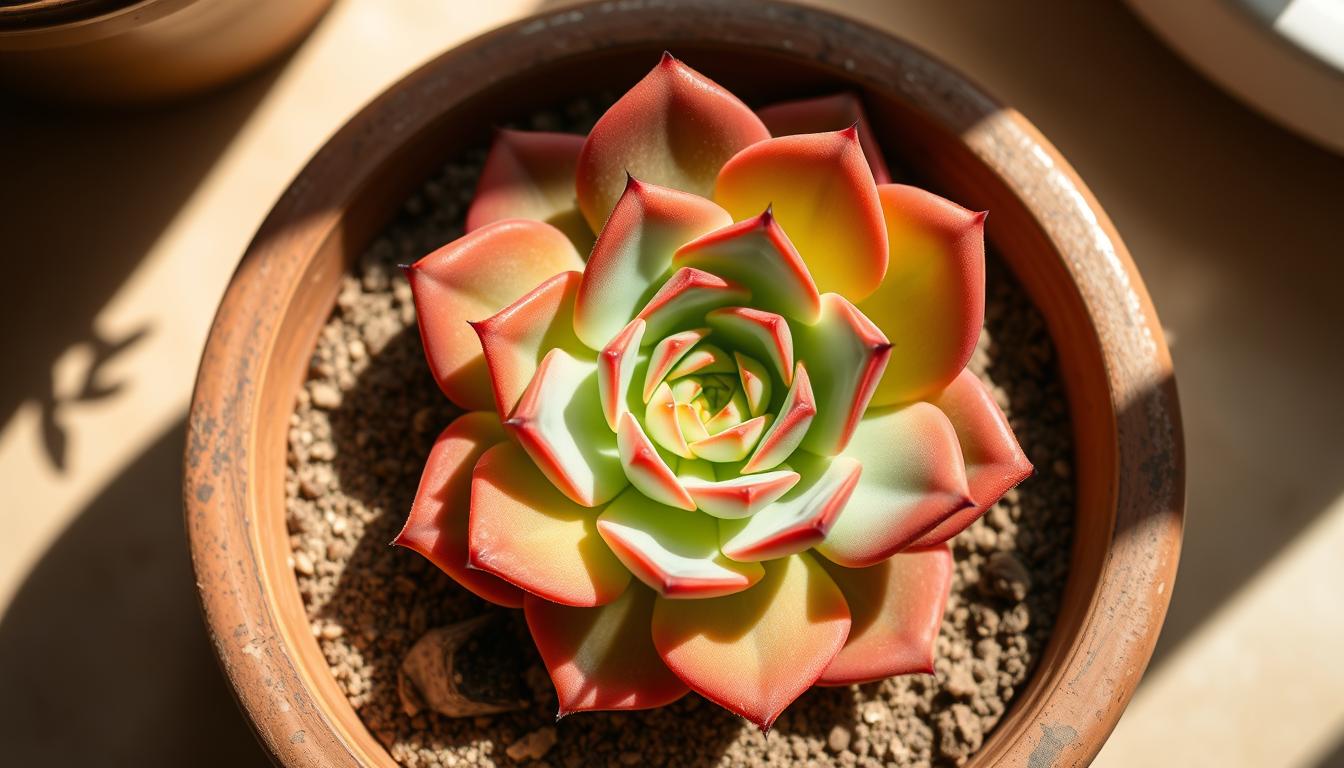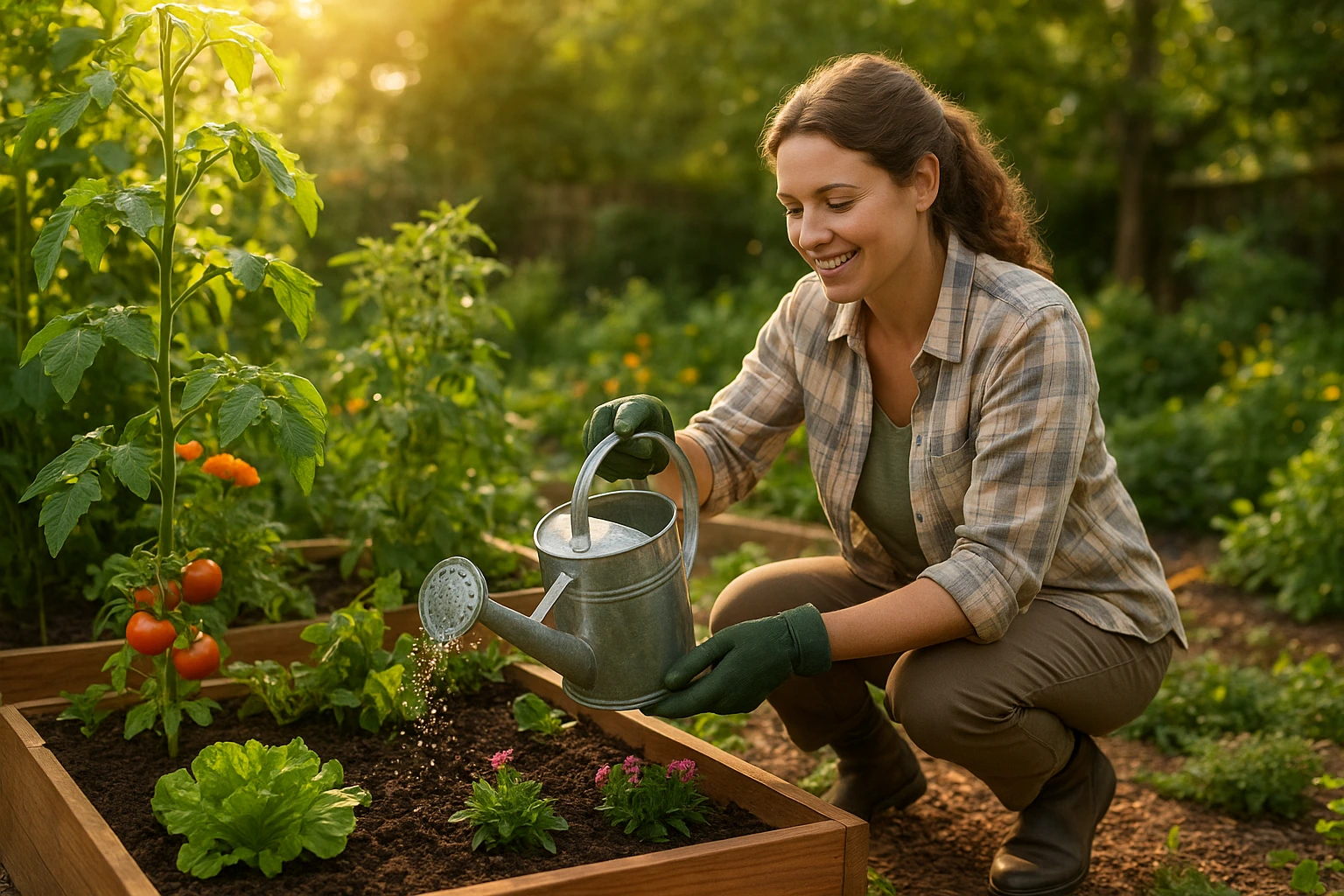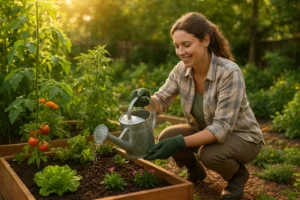Have you ever wondered about the captivating beauty of the Echeveria agavoides, also known as the “Mexican Hens and Chicks”?
This succulent is from San Luis Potosi in Mexico. It’s a standout in the world of drought-tolerant plants.
Its distinctive pointed leaves and vibrant colors make it a must-have.
You can find it in shades of red, green, orange, and yellow. It’s perfect for any indoor or outdoor garden.
Key Takeaways
- Echeveria agavoides is a stunning succulent native to Mexico, known for its unique pointed leaves and vibrant colors.
- This low-maintenance plant is highly adaptable and can thrive in a variety of growing conditions, including full sun and partial shade.
- Echeveria agavoides is well-suited for both indoor and outdoor cultivation, making it a versatile choice for gardeners and plant enthusiasts.
- With its exceptional drought tolerance and resistance to pests, Echeveria agavoides is an ideal choice for those seeking a durable and eye-catching succulent.
- Proper soil drainage and watering habits are essential for the optimal growth and health of this beautiful succulent.
Introduction to the Mexican Hens and Chicks
Echeveria agavoides, also known as the Mexican hens and chicks, is a stunning succulent.
It comes from the central region of San Luis Potosi, Mexico. This hardy plant loves higher altitudes and can grow in many places.
It’s famous for its unique rosette shape, pointed leaves, and colors that change from green to red.
Origin and Natural Habitat
Echeveria agavoides comes from San Luis Potosi, Mexico.
It grows well at high elevations. This succulent has learned to survive in the tough mountain climate.
Key Characteristics
The Mexican hens and chicks have a special rosette shape. Each plant has a group of pointed, thick leaves.
They can grow up to 12 inches wide.
Their leaves change color based on light and stress.
They can even handle light frost, staying alive down to 20°F.
Understanding Echeveria Agavoides Varieties
There are many varieties of Echeveria agavoides. Some favorites are ‘Bronze Beauty,’ ‘Lipstick,’ and ‘Miranda.’
Each variety has its own look and growth style.
These differences make the Mexican hens and chicks a favorite among plant lovers.
They’re great for both beginners and experts.

“Echeveria agavoides is an exceptionally hardy and adaptable succulent that thrives in a variety of conditions, making it a popular choice among growers.”
The Distinctive Features of Echeveria Agavoides
Echeveria agavoides, also known as the Molded Wax Agave, is a stunning succulent.
It has a compact rosette that can grow up to 12 inches wide.
The leaves are plump and range in color from bright green to vibrant reds and oranges.
A thin, chalky coating on the leaves adds to its beauty.
The leaves of Echeveria agavoides are pointed and spoon-like, tapering to a sharp tip.
This shape gives the plant a unique, architectural look.
As it matures, the leaves may turn reddish, showing off their beauty in bright sunlight.
Echeveria agavoides can handle light frost, staying healthy down to 20°F.
This makes it a great choice for gardeners in cooler climates.
Even though it’s hardy, the true Echeveria agavoides is very rare. Most available are hybrids or cultivars.
| Characteristic | Description |
| Rosette Diameter | Up to 12 inches |
| Leaf Color | Bright green, vibrant reds, oranges |
| Leaf Surface | Thin, chalky coating |
| Leaf Shape | Pointed, spoon-like |
| Frost Tolerance | Down to 20°F |
| Rarity | True species is exceptionally rare |
Echeveria agavoides is a standout in any succulent collection.
Its compact size, vibrant colors, and cold tolerance make it a favorite among gardeners and plant lovers.

Perfect Growing Conditions for Your Succulent
To grow Echeveria agavoides well, knowing the right conditions is essential.
This drought-tolerant plant loves bright sunlight and does great indoors with enough light.
We will look at the temperature, light, and humidity needs for your Echeveria agavoides to thrive.
Temperature Requirements
Echeveria agavoides can’t handle frost but does okay above freezing.
It prefers warm weather and grows best in USDA zones 9-12.
In these zones, winter temperatures stay above 50°F.
During hot months, it can handle full sun without problems.
Light Exposure Needs
Echeveria agavoides needs lots of direct sunlight to do well. It loves full sun, best in the morning.
In the afternoon, it does well with some shade to avoid sunburn.
Mature plants can take full sun all day, but young ones might need shade from strong midday sun.
Humidity Considerations
Humidity isn’t a big deal for Echeveria agavoides.
It’s made for dry places and grows well indoors and outdoors.
This makes it a great choice for those looking for easy-to-care-for plants.

“Echeveria agavoides is known for its easy-to-grow nature and adaptability, making it a popular choice among both novice and experienced succulent enthusiasts.”
Echeveria Agavoides: Soil and Potting Requirements
Echeveria agavoides is a stunning succulent that loves well-draining soil.
This is because it comes from Mexico.
To make the best soil, mix 50-70% mineral grit like coarse sand, pumice, or perlite with succulent soil.
This mix helps with drainage and aeration, key for these plants.
For potting, choose shallow containers like azalea pots or bowls.
They should be a bit bigger than the plant. Avoid over-potting, which can cause root rot.
Repotting every 1-2 years with fresh, draining soil keeps the plant healthy and strong.
| Soil Composition | Pot Type | Repotting Frequency |
| 50-70% mineral grit (coarse sand, pumice, or perlite) + succulent soil | Shallow containers (azalea pots or bowls) | Every 1-2 years |
Choosing the right soil and potting setup is key. It helps your Echeveria agavoides grow well.
They become beautiful, drought-resistant plants in your succulent collection.

Watering Guidelines and Schedule
Watering your Echeveria agavoides right is key to its health and beauty.
This succulent loves a deep but not too often watering. Let the soil dry out fully before you water again.
Seasonal Watering Adjustments
In the hot summer, when it’s over 95°F, water your Echeveria agavoides every 1-2 weeks.
But when it gets cooler in winter, water less to avoid rot.
Try not to water from above, as it can cause diseases, more so in the cold months.
Signs of Over and Under-Watering
- Overwatering: Yellow leaves and stem rot mean your Echeveria agavoides is getting too much water. Wait until the soil is dry before watering again.
- Underwatering: Wrinkled or falling leaves show your succulent needs more water. Give it a good soaking, letting the extra water drain.
Stick to these watering tips and adjust with the seasons.
Your Echeveria agavoides will flourish as a low-care, drought-resistant succulent in your collection.
Color Changes and Stress Responses

Echeveria agavoides, also known as Mexican hens and chicks succulent, changes color in response to its environment.
This change is not just beautiful but also helps protect the plant.
More sun and a bit of water stress can make the leaves of Echeveria agavoides turn red, more so at the edges.
The ‘Lipstick’ variety, for example, shows off its red edges more when it gets lots of sunlight.
Also, the colors of Echeveria agavoides change with the seasons, getting deeper and richer in winter.
Succulents like Echeveria agavoides change color when they get too much sun.
They use red anthocyanin, orange carotene, and yellow xanthophyll to protect themselves.
When stressed, they tighten up, showing off red, orange, yellow, rose, or purple colors.
Not all echeveria agavoides change color dramatically when stressed.
For example, agaves don’t change color as much as other succulents.
Watching how echeveria agavoides react to sun, temperature, and water is key.
“Succulents can undergo multiple color changes throughout their lifespan influenced by their surroundings.”
When in bright sunlight, echeveria agavoides can turn from green to vibrant reds or deep purples.
How often and how you water it, and temperature changes, all affect its color.
It’s best to introduce stress slowly to avoid harming the plant. Healthy echeveria agavoides can handle stress better than smaller or newly planted ones.
Knowing how echeveria agavoides changes color and reacts to stress helps us care for it better.
This way, we can truly enjoy the beauty of these Mexican hens and chicks succulent.
Propagation Methods and Techniques
Echeveria agavoides, also known as “Mexican Hens and Chicks,” is a stunning succulent.
It’s easy to grow and can be shared with others. Knowing how to propagate it is important for its success.
Leaf Propagation
Leaf propagation is a common way to grow Echeveria agavoides. It’s a bit tricky but can be very rewarding.
To start, cut off a healthy leaf and let it dry for a bit.
Then, plant it in soil that drains well. Soon, roots will grow, and a new plant will appear.
Offset Division
Offset division is the best way to grow Echeveria agavoides. These plants make offsets, or “chicks,” at their base.
You can separate these and plant them in their own pots.
Make sure each offset has good roots before planting. This way, they can grow into new plants.
Stem Cuttings
Stem cuttings are another good method. Cut a healthy stem, let it dry, and then plant it.
This is great for taller plants, helping them become more compact.
It’s key to give your cuttings or offsets the right care. They need sunlight, good soil, and the right amount of water.
“Echeveria agavoides is a true succulent gem, and with the right propagation techniques, you can easily multiply its beauty and share it with others.”
Common Cultivars and Varieties
Echeveria agavoides is a stunning rosette-forming plant with many cultivars.
These range from ‘Bronze Beauty’ with its bronze hue to ‘Lipstick’ with its bright color.
Each variety has its own special look and traits.
‘Miranda’ is known for its reddish-purple leaves that turn blue-green when stressed.
Frank Reneilt’ is loved for its small size and many offsets, perfect for pots and arrangements.
‘Love’s Fire’ stands out with its bold red-orange leaves and frequent offsets. On the other hand, ‘Ebony’ grows big and is a standout in any collection.
‘Romeo Rubin’ has deep burgundy leaves, while ‘Maria’ has a delicate, almost see-through look.
These echeveria agavoides varieties add beauty and variety to any plant collection.
| Cultivar | Leaf Color | Growth Habit | Key Features |
| Bronze Beauty | Bronze | Compact | Attractive bronze coloration |
| Lipstick | Red-orange | Rosette | Vibrant, lipstick-colored leaves |
| Miranda | Reddish-purple | Rosette | Develops blue-green hues under stress |
| Frank Reneilt | Green | Compact, offsetting | Abundant offsets, suitable for containers |
| Love’s Fire | Red-orange | Rosette, offsetting | Fiery red-orange leaves, frequent pupping |
| Ebony | Deep burgundy | Large | Can grow quite large, striking appearance |
| Romeo Rubin | Deep burgundy | Rosette | Distinctive deep burgundy foliage |
| Maria | Green, translucent | Rosette | Delicate, almost transparent appearance |
These are just a few of the many echeveria agavoides varieties out there.
Each one brings its own beauty and flexibility, making them a favorite among plant lovers.
Seasonal Care and Maintenance
Echeveria agavoides, also known as “Mexican Hens and Chicks,” needs special care all year.
It’s a low-maintenance houseplant that thrives with the right seasonal care. Knowing its needs helps keep your Echeveria happy and healthy.
In spring and summer, your Echeveria agavoides need a bit more water and shade from strong sun.
Water when the top inch of soil is dry, don’t overwater.
Feed it with a diluted fertilizer or slow-release granules to help it grow.
When autumn comes, water less and give it more light. This helps your Echeveria show off its beautiful stress colors.
These colors are a natural part of the plant’s cycle.
In winter, your Echeveria needs the least water as it rests.
Keep it away from frost and ensure good air flow to avoid fungal diseases.
Don’t prune or repot during this time.
- Provide more water and shade from intense sun in spring and summer
- Reduce watering and increase light exposure in fall to encourage stress coloration
- Minimize watering and protect from frost during the winter dormancy period
- Ensure good air circulation year-round to prevent pests and diseases
- Regularly remove any dead or damaged leaves to maintain a healthy appearance
By adjusting your care to the seasons, your Echeveria agavoides will thrive.
It’s a low-maintenance succulent that brings natural beauty to your home. With the right care, it will continue to impress you every year.
Troubleshooting Growth Issues
Keeping your echeveria succulent healthy and vibrant can be a challenge. But, with some troubleshooting, you can solve common growth problems.
From pests to diseases, knowing the signs and acting fast is key to a thriving plant.
Common Pests
Echeveria plants face pests like mealybugs, scale insects, and aphids.
These pests can harm leaves and stems, causing color changes, slow growth, and even death.
Check your echeveria often for pests. Use insecticidal soap or neem oil to fix the problem quickly.
Disease Prevention
Root rot is a big problem for echeverias, usually from too much water.
Watch your watering and make sure the soil drains well.
Good air flow helps prevent fungal diseases. If you see color changes or soft leaves, act fast to fix it.
Recovery Tips
- If your echeveria stretches from lack of light, move it to a brighter spot and trim the long parts.
- For root rot from too much water, stop watering, let the soil dry, and remove bad parts of the plant.
- To fight pests, use insecticidal soap or neem oil on all leaves and stems.
- If your echeveria isn’t doing well, try repotting it in fresh, draining succulent soil for better growth.
By watching closely and fixing problems fast, your echeveria will stay beautiful and strong.
With proper care, these plants can live for many years.
Decorative Uses and Display Ideas
Echeveria agavoides is a stunning succulent that can brighten up any space.
It’s perfect for rock gardens, succulent arrangements, and as a solo showpiece. Its small size makes it great for tight spots, adding vibrant colors and textures to your decor.
In warm climates, it fits right into outdoor gardens, making them more interesting.
Indoors, place it near a sunny window or under grow lights. This lets you see its beautiful color changes and reactions to stress all year.
To make a striking succulent display, mix Echeveria agavoides with Sempervivum and Aeonium.
Their different colors and leaf shapes create a stunning display.
Try using various containers, from terracotta to modern ceramics, to highlight your succulents’ beauty.
| Decorative Idea | Benefits | Styling Tips |
| Front Yard Border | Year-round visual interest, drought-tolerant | Combine with other rosette-forming plants, stagger heights for depth |
| Vertical Succulent Wall | Space-saving, adaptable to various light conditions | Use a variety of echeveria, sedum, and aloe species, group by color |
| Tabletop Succulent Garden | Compact, low-maintenance, visually appealing | Mix different textures and heights, include trailing varieties |
Displaying Echeveria agavoides in any way will bring natural elegance to your space.
Its unique shape and colors make it a versatile choice.
Let your creativity run wild with this low-maintenance houseplant.
“Echeveria agavoides is a stunning succulent that can transform any space with its vibrant colors and unique textures.”
Conclusion
The Echeveria agavoides, also known as the Mexican Hens and Chicks, is a fascinating succulent.
It can grow well in many conditions. Its easy care and beautiful look make it great for all gardeners.
It’s perfect for adding desert charm indoors or creating a beautiful outdoor display.
This plant is sure to impress.
With the right soil, light, and water, Echeveria agavoides will bloom beautifully for years.
Knowing its needs keeps your succulent collection looking good. Exploring different varieties like ‘Ebony,’ ‘Lipstick,’ and ‘Romeo’ reveals their unique beauty.
The Echeveria agavoides shows the beauty and toughness of succulents.
Adding it to your space brings beauty and calm.
Learning about this succulent can inspire a stunning collection that celebrates nature’s adaptability.
FAQ
Q: What is Echeveria agavoides?
Echeveria agavoides, also known as “Mexican Hens & Chicks,” is a stunning succulent from Mexico. It has distinctive pointed leaves and can show colors like red, green, orange, and yellow.
Q: Where does Echeveria agavoides originate from?
Echeveria agavoides comes from the central part of San Luis Potosi, Mexico. It grows at higher altitudes. It’s known for its rosette shape, pointed leaves, and changing colors.
Q: What are the distinctive features of Echeveria agavoides?
Echeveria agavoides has unique pointed leaves that form a compact rosette. The leaves can be apple green or vibrant reds and oranges, often with red edges. A thin, silvery layer of farina covers the leaves, making them even more appealing.
Q: What are the ideal growing conditions for Echeveria agavoides?
Echeveria agavoides loves bright sunlight. It prefers full sun in the morning and partial shade in the afternoon. As it matures, it can handle full sun all day. It needs well-draining soil, best mixed with 50-70% mineral grit and succulent soil.
Q: How should I water Echeveria agavoides?
Water Echeveria agavoides deeply but not too often. Let the soil dry completely between waterings. In summer, water more when it’s over 95°F. Water less in winter to avoid rot.
Q: How does Echeveria agavoides respond to environmental factors?
Echeveria agavoides changes color with the environment. More sun and a bit of water stress can make the leaves redder, mainly at the edges. Color changes also happen with the seasons, with deeper colors in winter.
Q: How can I propagate Echeveria agavoides?
Echeveria agavoides easily produces offsets or “chicks” at the base. These can be separated and replanted. Leaf propagation is tricky, but stem cuttings work well too.
Q: What are some popular Echeveria agavoides cultivars?
Popular varieties include ‘Bronze Beauty,’ ‘Lipstick,’ ‘Miranda,’ ‘Frank Reneilt,’ ‘Love’s Fire,’ ‘Romeo Rubin,’ ‘Ebony,’ and ‘Maria.’ Each has its own leaf shape, color, and growth style.
Q: How do I care for Echeveria throughout the seasons?
In spring and summer, water more and protect from strong afternoon sun. In fall, water less and give it more light to show off color changes. In winter, water very little and keep it away from frost.
Q: What are some common issues with Echeveria agavoides?
Issues include etiolation (stretching) from too little light, root rot from too much water, and pests like mealybugs. Keep diseases away by watering right and ensuring good air flow.
Q: How can I use Echeveria agavoides in my home décor?
Echeveria agavoides is great for decorating. It’s perfect for rock gardens, succulent displays, and as a solo plant. Its compact shape is great for small spaces. For indoor use, place it near a bright window or under grow lights.







